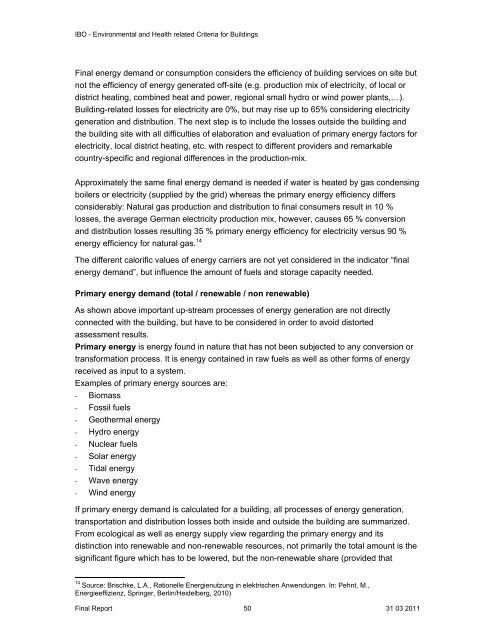Environmental and health related criteria for buildings - ANEC
Environmental and health related criteria for buildings - ANEC
Environmental and health related criteria for buildings - ANEC
You also want an ePaper? Increase the reach of your titles
YUMPU automatically turns print PDFs into web optimized ePapers that Google loves.
IBO - <strong>Environmental</strong> <strong>and</strong> Health <strong>related</strong> Criteria <strong>for</strong> Buildings<br />
Final energy dem<strong>and</strong> or consumption considers the efficiency of building services on site but<br />
not the efficiency of energy generated off-site (e.g. production mix of electricity, of local or<br />
district heating, combined heat <strong>and</strong> power, regional small hydro or wind power plants,…).<br />
Building-<strong>related</strong> losses <strong>for</strong> electricity are 0%, but may rise up to 65% considering electricity<br />
generation <strong>and</strong> distribution. The next step is to include the losses outside the building <strong>and</strong><br />
the building site with all difficulties of elaboration <strong>and</strong> evaluation of primary energy factors <strong>for</strong><br />
electricity, local district heating, etc. with respect to different providers <strong>and</strong> remarkable<br />
country-specific <strong>and</strong> regional differences in the production-mix.<br />
Approximately the same final energy dem<strong>and</strong> is needed if water is heated by gas condensing<br />
boilers or electricity (supplied by the grid) whereas the primary energy efficiency differs<br />
considerably: Natural gas production <strong>and</strong> distribution to final consumers result in 10 %<br />
losses, the average German electricity production mix, however, causes 65 % conversion<br />
<strong>and</strong> distribution losses resulting 35 % primary energy efficiency <strong>for</strong> electricity versus 90 %<br />
energy efficiency <strong>for</strong> natural gas. 14<br />
The different calorific values of energy carriers are not yet considered in the indicator “final<br />
energy dem<strong>and</strong>”, but influence the amount of fuels <strong>and</strong> storage capacity needed.<br />
Primary energy dem<strong>and</strong> (total / renewable / non renewable)<br />
As shown above important up-stream processes of energy generation are not directly<br />
connected with the building, but have to be considered in order to avoid distorted<br />
assessment results.<br />
Primary energy is energy found in nature that has not been subjected to any conversion or<br />
trans<strong>for</strong>mation process. It is energy contained in raw fuels as well as other <strong>for</strong>ms of energy<br />
received as input to a system.<br />
Examples of primary energy sources are:<br />
- Biomass<br />
- Fossil fuels<br />
- Geothermal energy<br />
- Hydro energy<br />
- Nuclear fuels<br />
- Solar energy<br />
- Tidal energy<br />
- Wave energy<br />
- Wind energy<br />
If primary energy dem<strong>and</strong> is calculated <strong>for</strong> a building, all processes of energy generation,<br />
transportation <strong>and</strong> distribution losses both inside <strong>and</strong> outside the building are summarized.<br />
From ecological as well as energy supply view regarding the primary energy <strong>and</strong> its<br />
distinction into renewable <strong>and</strong> non-renewable resources, not primarily the total amount is the<br />
significant figure which has to be lowered, but the non-renewable share (provided that<br />
14 Source: Brischke, L.A., Rationelle Energienutzung in elektrischen Anwendungen. In: Pehnt, M.,<br />
Energieeffizienz, Springer, Berlin/Heidelberg, 2010)<br />
Final Report 50 31 03 2011
















